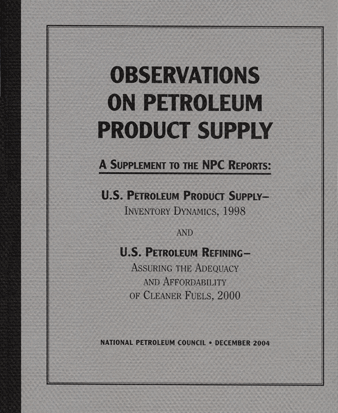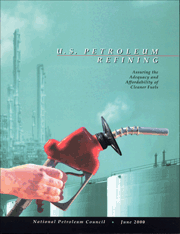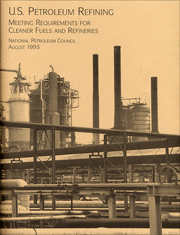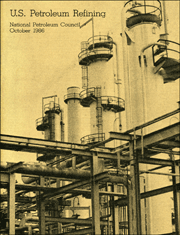|
|
|
Refining
A Supplement to the NPC Reports: This 2004 report responds to a request from the Secretary of Energy for the National Petroleum Council to provide advice on issues surrounding domestic refining capacity, product imports, and inventories. The Secretary requested that the Council’s advice be provided on an expedited schedule. The review of refining and inventory issues presents observations on petroleum product supply and an integrated response to the Secretary’s request for advice on both refining and inventory issues and is intended as an update and supplement to the 1998 and 2000 NPC reports on these subjects. The report provides insights on petroleum market dynamics as well as advice on actions that can be taken by industry and government to ensure adequate and reliable supplies of petroleum products to meet the energy and environmental requirements of American consumers. It includes the study’s interrelated refining and inventory analyses, which provide support for the report’s findings and recommendations. Additionally, the report responds to the Secretary’s request that the Council reexamine its 1998 advice on lower operational inventory levels for crude oil and petroleum products. Printed report: (96 pages) Price: $15.00
The report includes examinations of such factors as the state of development of process technology, refinery producibility, product delivery and testing considerations, and facility implementation requirements and capabilities. Appendices to the report include background material on refining and distribution, data on gasoline and diesel sulfur removal technologies, model results and methodologies, and details on construction scheduling and staffing. Recommendations are made regarding petroleum product specification regulations issued or proposed as of June 2000. The recommendations specifically address very low sulfur gasoline and diesel requirements, driveability index, environmental permitting, and the flexibility of the petroleum distribution system. Other specific recommendations address regulatory basis, timing, and certainty. Printed report: (Approximately 400 pages) Price: $30.00
To order any of the above, download and return this Petroleum Refining Report order form.
This six-volume report examines the factors affecting the outlook for U.S. refining during the period 1991-2010.
Executive Summary Click here to view/download a .pdf of the printed report (7 MB). Volume I - Analyses & Results Click here to view/download a .pdf of the printed report (17.5 MB). Volume II - General Information Appendices Click here to view/download a .pdf of the printed report (15.8 MB). Volume III - Financial & Facilities Appendices Click here to view/download a .pdf of the printed report (7.8 MB). Volume IV - Supply, Demand, & Logistics Appendix (in two parts) Click here to view/download a .pdf of Part I of the printed report (31 MB). Click here to view/download a .pdf of Part II of the printed report (19.4 MB). Volume V - Refining Capability Appendix Click here to view/download a .pdf of the printed report (17.2 MB). Volume VI - Survey Appendix Click here to view/download a .pdf of the printed report (11.4 MB). Printed report: Set of all of the above
U.S. Petroleum Refining (1986) The report examines the factors affecting domestic refining in the 1985-1990 time frame and evaluates future refinery operations and the role of small regional refineries. The study includes an extensive data base on the operating capacities, process utilizations, crude oil charge, and product yields for the period January 1, 1984 through the end of 1988. The data base includes 181 refineries, which reported an operable capacity of 15,314 thousand barrels per day or 96 percent of the total U.S. refining capacity reported operable to the U.S. Energy Information Administration as of January 1, 1985. The report also contains the results of two computer modeling studies of refinery operations. One analyzes the physical capabilities of the U.S. refining industry now and through 1990; the other analyzes the effects of changes in world product demand, product mix, and socioeconomic conditions on the domestic refining industry. Printed report: (650 pages) Price: $55.00 Click here to view/download a .pdf of the printed report (low-resolution version - 53.6 MB). The report examines the historical trends and current status of the domestic refining industry’s sources of crude oil and its capability to process these crudes in response to the demands for essential petroleum products. In particular, it presents the following analyses: projections of U.S. and world petroleum supply/demand through 1990; the U.S. refining industry’s capability to process available crude oils and to meet product demand under a variety of supply/demand scenarios; the competitive economics of different sizes and types of refineries in the United States; and the relative economics of domestic and foreign export refineries when supplying petroleum products to the U.S. East Coast. In 1979, the National Petroleum Council published Refinery Flexibility - An Interim Report, which contains the results of industry surveys analyzed in this report. Printed report: (440 pages) Price: $27.50 Click here to view/download a .pdf of the printed report (36.1 MB). updated 9/18/14
. |



